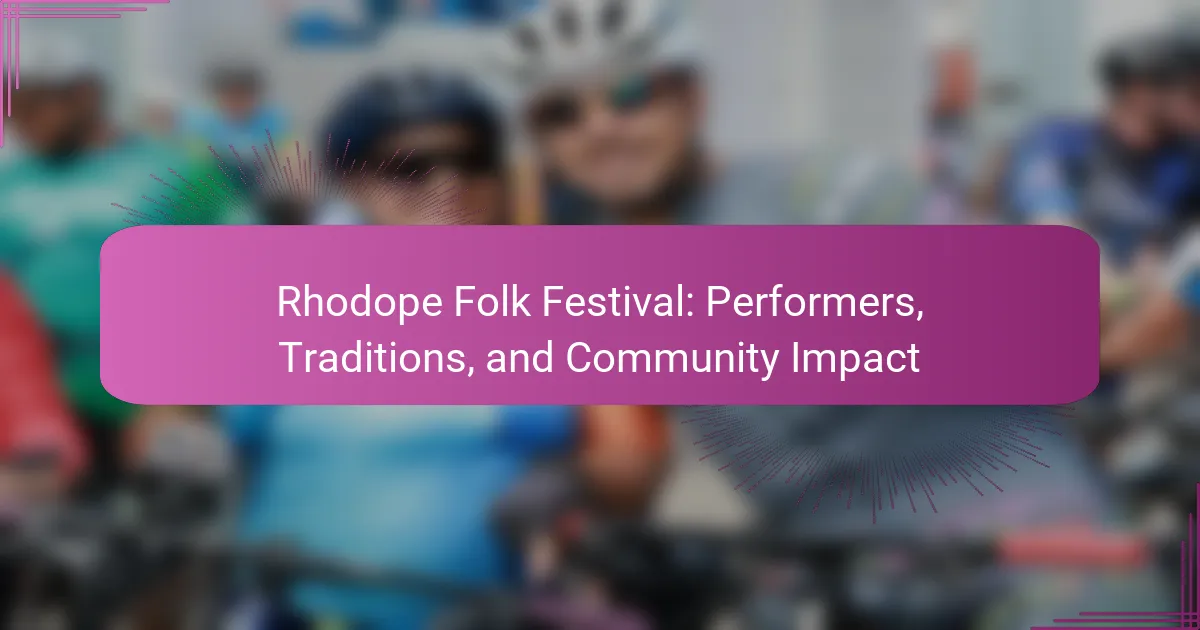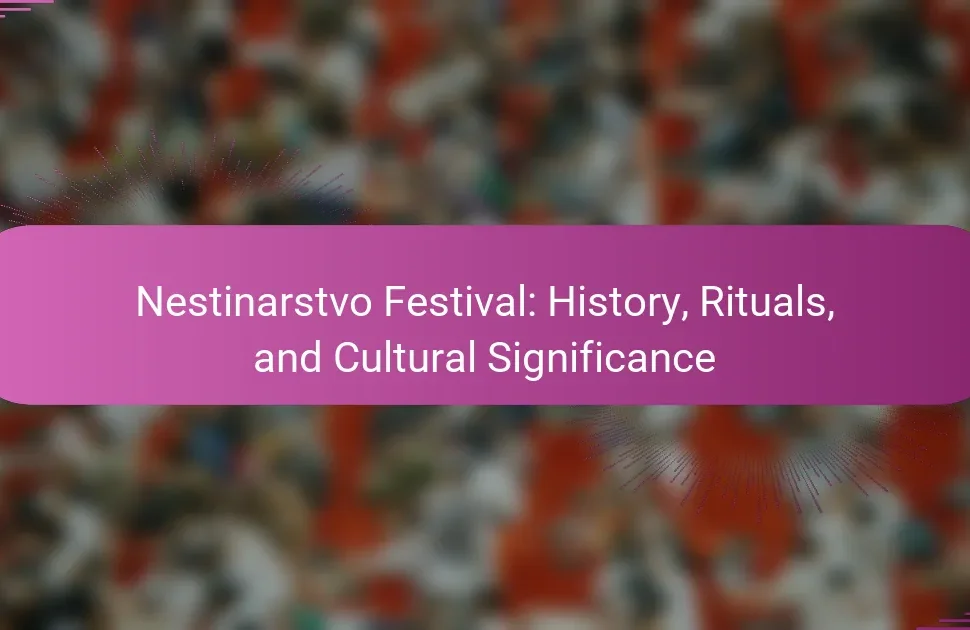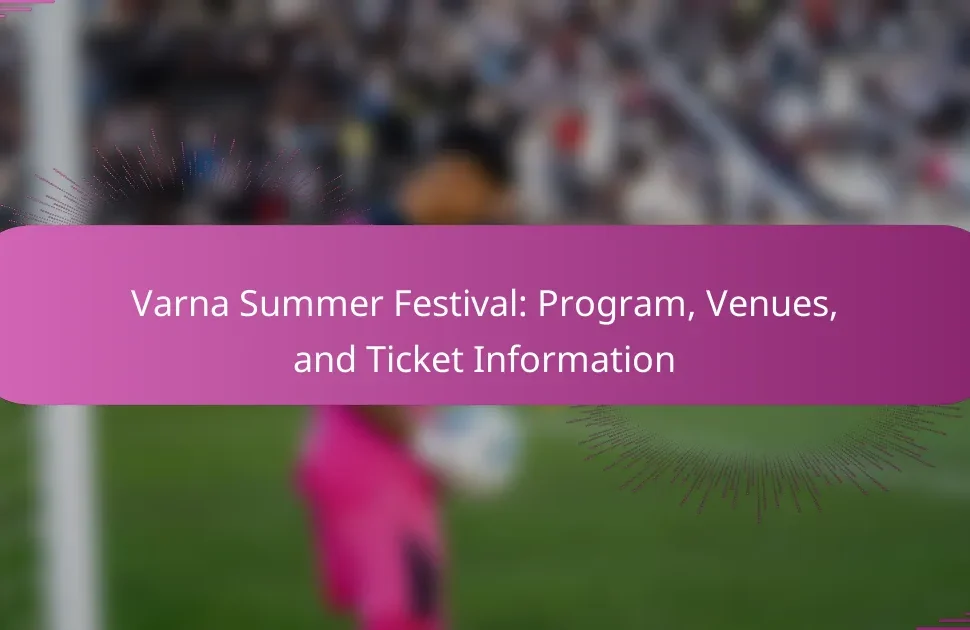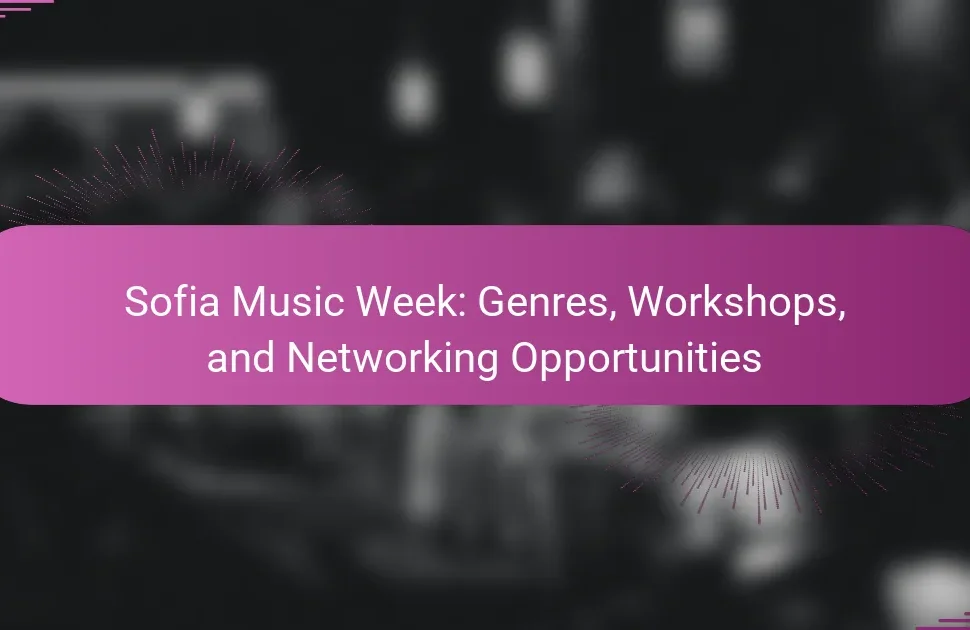The Rhodope Folk Festival plays a vital role in preserving cultural heritage while enhancing community spirit. It features performances by renowned folk musicians and traditional dance troupes. The festival showcases authentic Rhodopean songs and crafts, promoting local artisans and fostering cultural exchange. However, challenges like dwindling participation and competition from modern entertainment threaten its sustainability.
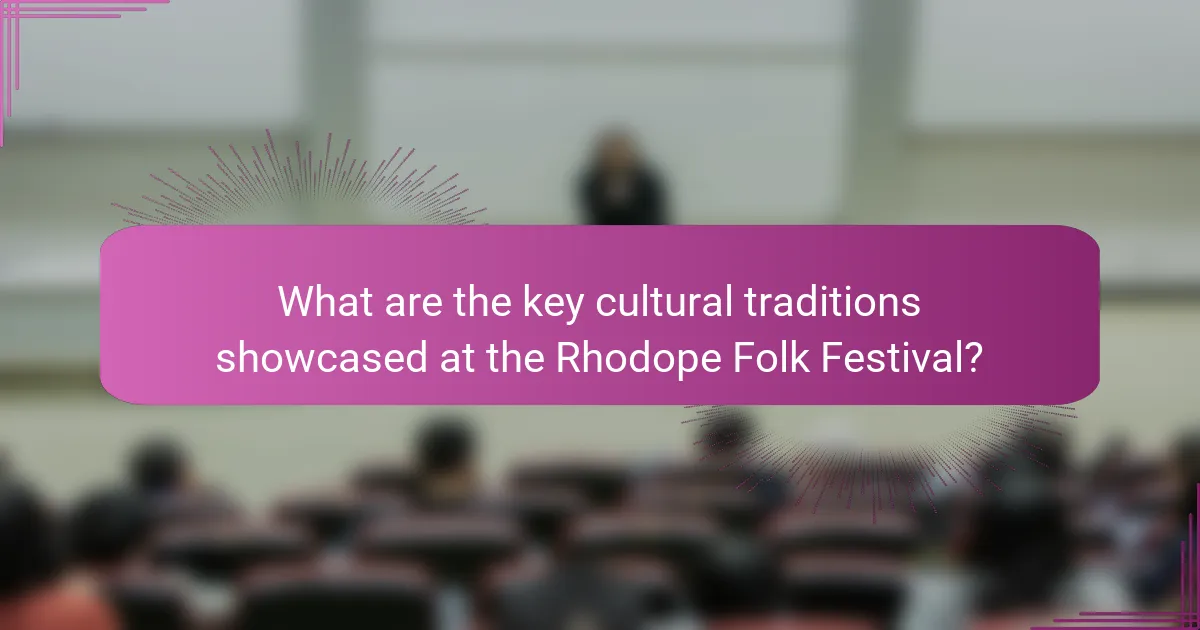
What are the key cultural traditions showcased at the Rhodope Folk Festival?
The Rhodope Folk Festival showcases vibrant cultural traditions through music, dance, and crafts. Key traditions include the performance of authentic Rhodopean songs, showcasing traditional instruments like the gaida and kaval, and the presentation of folk dances such as the horo. Community involvement is significant, with local artisans displaying handmade crafts that reflect regional heritage. The festival fosters cultural exchange, preserving unique attributes of Rhodope culture while promoting community unity and identity.
How do local customs influence festival performances?
Local customs significantly shape festival performances by influencing themes, costumes, and music styles. At the Rhodope Folk Festival, traditional elements reflect the community’s cultural identity. Performers often incorporate local folklore, enhancing authenticity and audience connection. Additionally, customs dictate the rituals and interactions during performances, fostering a sense of belonging and continuity within the community. This integration of local customs enriches the festival experience, showcasing the region’s unique heritage.
Which traditional instruments are featured in the festival?
The Rhodope Folk Festival features traditional instruments such as the gaida, kaval, tambura, and tapan. These instruments are integral to the festival’s vibrant musical performances, showcasing the rich cultural heritage of the Rhodope region. The gaida, a type of bagpipe, is known for its unique sound, while the kaval, a wooden flute, adds melodic depth. The tambura, a long-necked lute, and the tapan, a large drum, enhance the rhythmic elements of the performances. Together, these instruments create an authentic folk music experience, celebrating community traditions.
What role does folk attire play in the festival’s cultural representation?
Folk attire plays a crucial role in the Rhodope Folk Festival’s cultural representation by showcasing regional identity and heritage. The vibrant costumes reflect traditional craftsmanship and local customs, enhancing the festival’s authenticity. Each outfit often features unique patterns and colors, symbolizing various aspects of the community’s history and values. As a result, folk attire not only preserves cultural narratives but also fosters a sense of unity among performers and attendees.
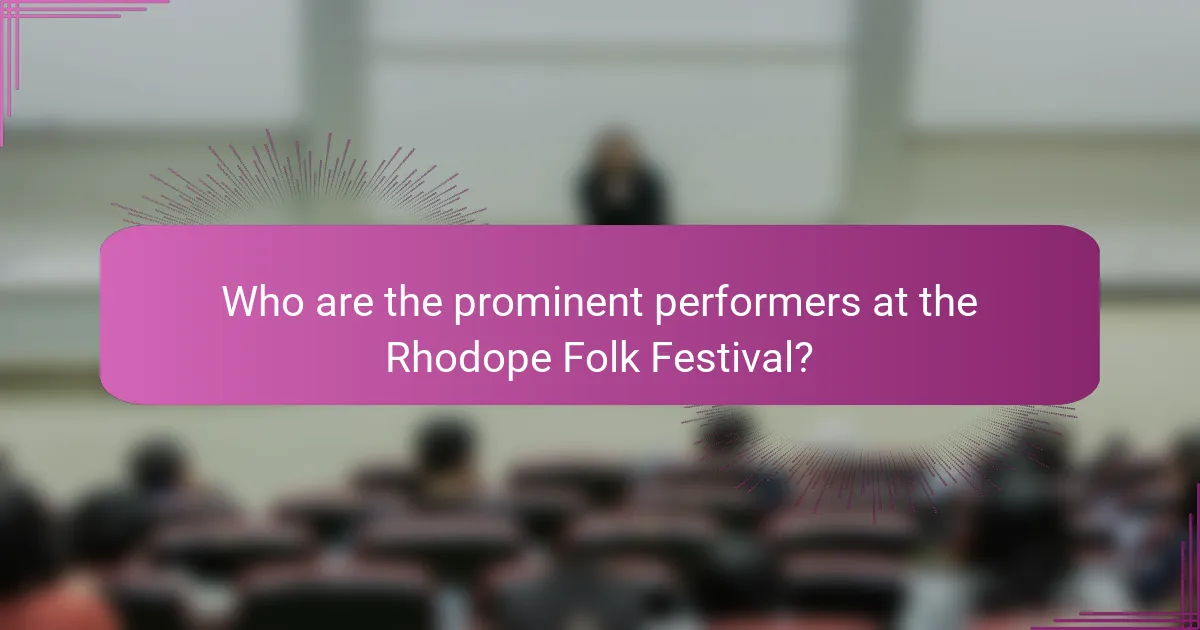
Who are the prominent performers at the Rhodope Folk Festival?
The prominent performers at the Rhodope Folk Festival include renowned folk musicians and traditional dance troupes. Artists such as Teodora Tzvetkova and the Rhodope Ensemble showcase authentic regional music. Their performances highlight the rich cultural heritage and community spirit of the Rhodope Mountains. The festival attracts diverse talent, creating a vibrant atmosphere that celebrates local traditions.
What are the backgrounds of the featured artists?
The featured artists at the Rhodope Folk Festival come from diverse cultural backgrounds. Many are rooted in the rich traditions of the Rhodope Mountains, showcasing unique folk music styles. Artists often include local musicians, dancers, and choirs, preserving the area’s cultural heritage. Their performances highlight traditional instruments, such as the gaida and tambura, emphasizing the festival’s commitment to community and tradition.
How do performers prepare for their festival appearances?
Performers prepare for the Rhodope Folk Festival by practicing traditional songs and dances, ensuring they embody the cultural heritage. They often engage in group rehearsals to foster teamwork and refine their performances. Additionally, they may participate in workshops to enhance their skills and learn new techniques. Community support plays a significant role, with local mentors guiding performers in preserving authentic traditions.
Which groups have gained recognition through the festival?
The Rhodope Folk Festival has recognized various groups, including local choirs, dance ensembles, and instrumentalists. These performers showcase traditional Rhodope music and dance, enriching cultural heritage. Notably, regional ensembles have gained prominence, fostering community spirit and cultural pride. Additionally, international participants have broadened the festival’s appeal, promoting cultural exchange.
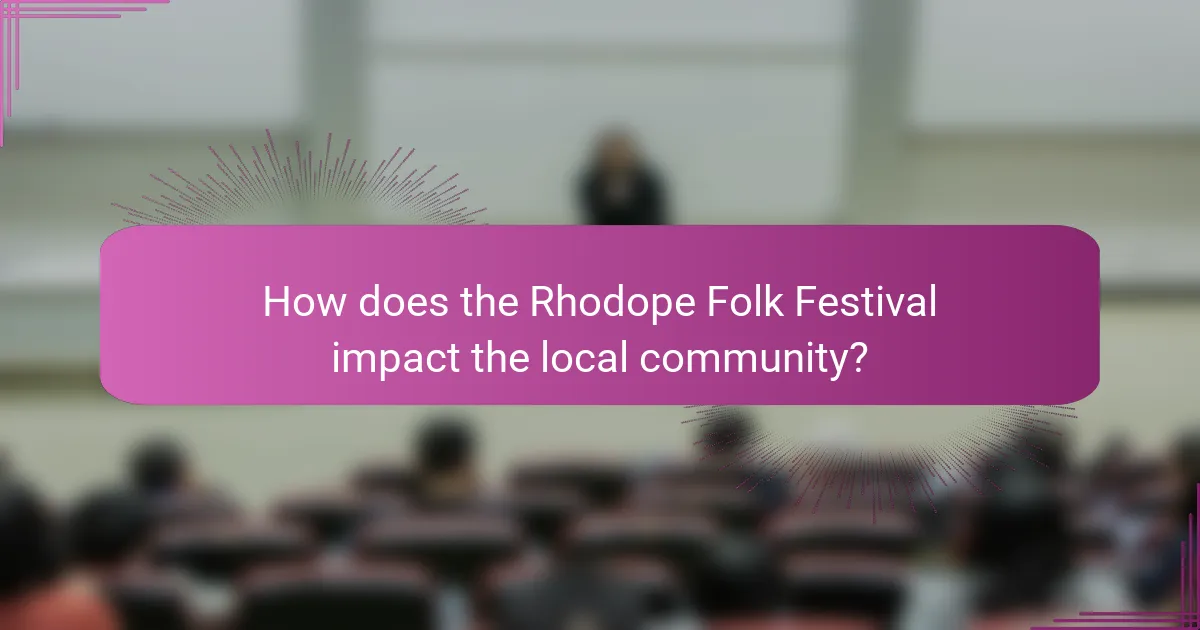
How does the Rhodope Folk Festival impact the local community?
The Rhodope Folk Festival significantly enhances the local community through cultural preservation and economic stimulation. It showcases traditional music and dance, fostering community pride and identity. The festival attracts tourists, generating revenue for local businesses and promoting regional crafts. As a result, it strengthens social ties and encourages younger generations to engage with their heritage.
What economic benefits does the festival bring to the region?
The Rhodope Folk Festival generates significant economic benefits for the region. It attracts thousands of visitors, boosting local tourism and hospitality sectors. Increased foot traffic leads to higher sales for local businesses, including restaurants and shops. Additionally, the festival creates job opportunities, contributing to the community’s overall economic vitality. The cultural exposure enhances the region’s attractiveness for future events, fostering long-term economic growth.
How does the festival foster community spirit and engagement?
The Rhodope Folk Festival fosters community spirit and engagement through cultural exchange and collaboration. Local performers showcase traditional music and dance, strengthening connections among attendees. Workshops and interactive sessions encourage participation, allowing community members to share their heritage. The festival promotes unity by celebrating diversity and fostering a sense of belonging.
What educational initiatives arise from the festival?
The Rhodope Folk Festival fosters educational initiatives that promote cultural heritage and community engagement. Workshops and seminars educate attendees on traditional music, dance, and crafts. These programs enhance skills and preserve local customs. Collaborations with schools encourage youth participation, ensuring traditions are passed to future generations. Additionally, the festival provides resources for local artists, supporting their development and visibility.
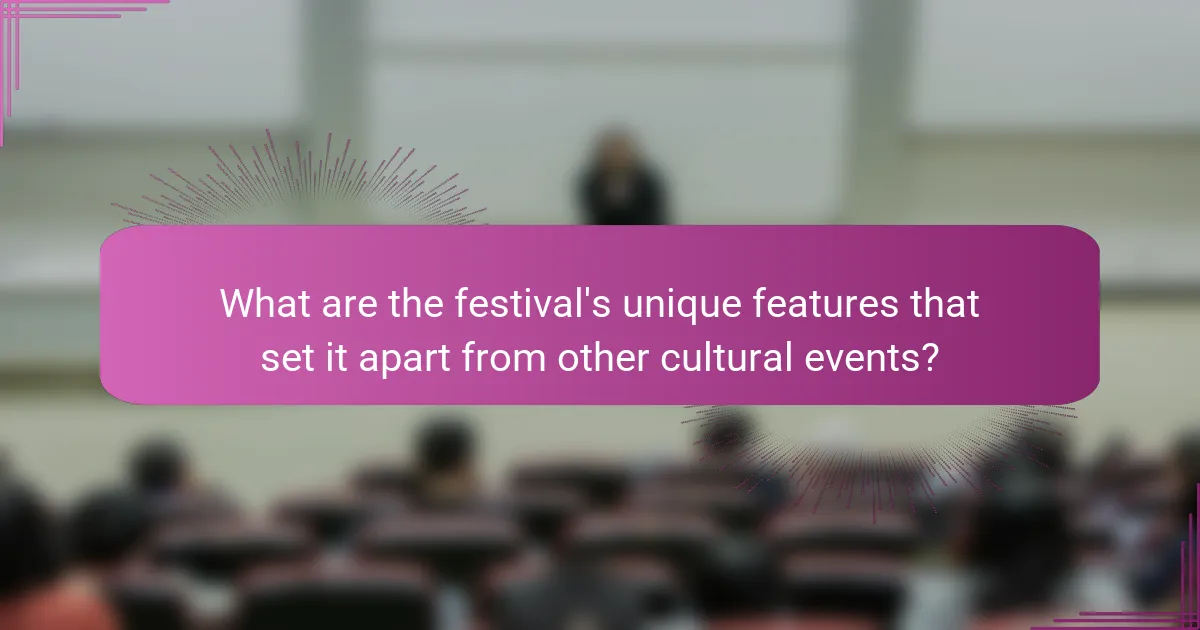
What are the festival’s unique features that set it apart from other cultural events?
The Rhodope Folk Festival stands out due to its rich cultural heritage, unique musical styles, and community involvement. The festival showcases traditional Rhodope music and dance, featuring local performers who preserve these age-old customs. Additionally, it fosters community spirit by engaging residents and visitors alike in cultural exchange and collaboration. The festival’s emphasis on authentic regional traditions and its role in promoting local artisans further differentiate it from other cultural events.
How does the festival incorporate modern elements while preserving tradition?
The Rhodope Folk Festival blends modern elements with tradition through innovative performances and contemporary interpretations of folklore. Artists incorporate modern instruments and technology while maintaining authentic Rhodopean music and dance styles. This fusion attracts diverse audiences, ensuring community engagement and cultural preservation. The festival showcases both established and emerging performers, highlighting the evolution of traditional practices in a modern context.
What rare performances or collaborations have occurred at the festival?
Rare performances at the Rhodope Folk Festival include collaborations between traditional musicians and contemporary artists. Notable instances feature the fusion of local folk sounds with modern genres, enhancing cultural exchange. Unique performances often highlight rare instruments, such as the gadulka, showcasing the festival’s commitment to preserving and innovating folk traditions. These collaborations not only entertain but also strengthen community bonds, making the festival a vibrant hub for artistic expression.
How does the festival adapt to changing audience preferences?
The Rhodope Folk Festival adapts to changing audience preferences by incorporating modern elements while preserving traditional performances. This balance attracts diverse age groups and enhances engagement. For example, the festival now features contemporary music styles alongside folk traditions, appealing to younger audiences. Additionally, interactive workshops allow participants to experience the culture firsthand, fostering a deeper connection. The festival’s commitment to community involvement ensures it remains relevant and responsive to local and visitor interests.
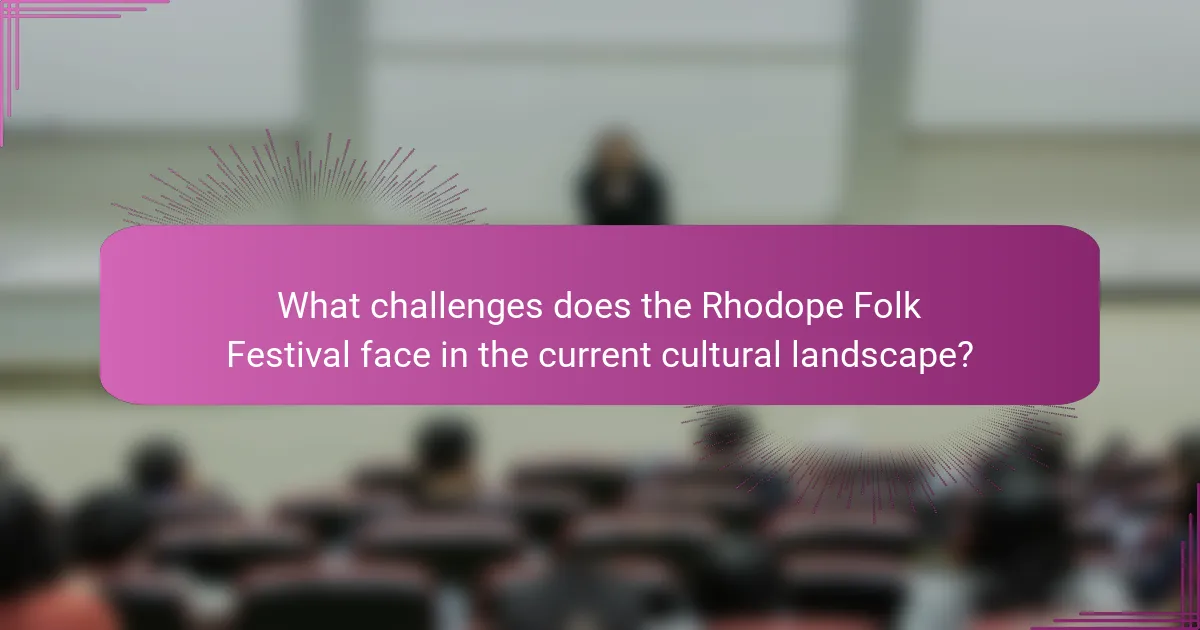
What challenges does the Rhodope Folk Festival face in the current cultural landscape?
The Rhodope Folk Festival faces challenges such as dwindling participation, cultural preservation, and competition from modern entertainment. These issues threaten its ability to maintain traditional performances and community engagement. The festival must adapt to attract younger audiences while honoring its unique heritage. Additionally, funding constraints limit its outreach and promotional efforts, impacting overall visibility and sustainability.
How does the festival address issues of sustainability?
The Rhodope Folk Festival promotes sustainability through eco-friendly practices and community engagement. The festival emphasizes local traditions and crafts, reducing environmental impact. It encourages the use of sustainable materials and supports local artisans, fostering economic growth while preserving cultural heritage. Additionally, the festival raises awareness about environmental issues, inspiring attendees to adopt sustainable practices in their daily lives.
What strategies are in place to ensure the festival’s longevity?
The Rhodope Folk Festival ensures longevity through community engagement, cultural preservation, and strategic partnerships. Active participation from local performers fosters a sense of ownership and pride. Educational programs promote traditional music and dance, ensuring youth involvement. Collaboration with regional organizations enhances resources and outreach. Sustainable practices, such as eco-friendly event management, contribute to the festival’s resilience. Regular feedback from attendees shapes future developments, maintaining relevance and appeal.
How do organizers respond to evolving cultural trends?
Organizers respond to evolving cultural trends by adapting festival themes, incorporating diverse performers, and engaging with local communities. They analyze audience preferences and societal shifts to ensure relevance and inclusivity. For example, the Rhodope Folk Festival showcases traditional music while embracing contemporary influences, reflecting changes in cultural expression. This approach fosters community pride and encourages participation across generations.
What are best practices for attendees to fully experience the festival?
To fully experience the Rhodope Folk Festival, attendees should engage with performances, participate in workshops, and connect with the community.
1. Attend diverse performances to appreciate traditional music and dance.
2. Participate in workshops to learn folk crafts and cultural practices.
3. Interact with local artists and performers to gain insights into their traditions.
4. Enjoy local cuisine to experience the region’s culinary heritage.
5. Explore the festival’s activities to understand its community impact and heritage.
